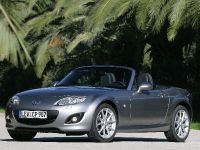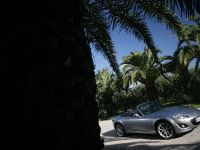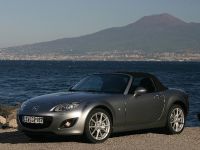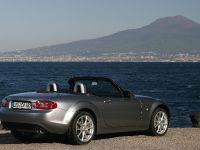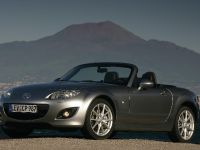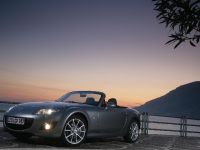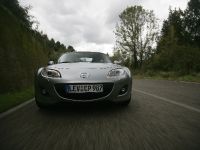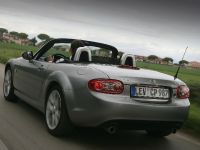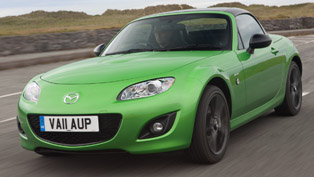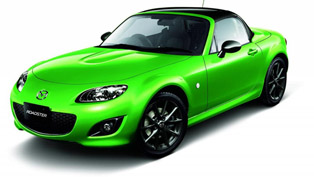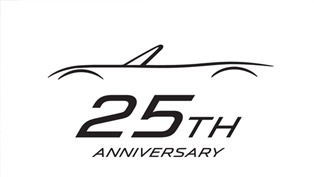Mazda MX-5 Facelift
Mazda MX-5 offers roadster driving at its best. Its original concept has been so successful that Mazda has never changed it: affordable to buy and use, lightweight, Jinba Ittai ‘onewith- the-car' handling, and classic roadster looks. The third generation launched in 2005 was developed with a strict ‘gram strategy' which helped to keep the weight at the same level while offering an even stiffer body and more equipment. This year Mazda introduces a facelift of the current third-generation MX-5 with enhancements that will attract even more people tothis unique, pure roadster.
This year marks the 20th anniversary of the Mazda MX-5, which is listed in the Guinness Book of World Records as the best-selling twoseat sports car ever (currently at 850,000 units). In fact, 855,000 MX-5 have been produced since launch in 1989, and 254,000 units were sold in Europe (through November 2008). The MX-5 has won a total of 178 major automotive awards in these two decades. The current third generation is no exception and carried home 58 awards – including Japan Car of the Year 2005-2006 and Top Gear magazine's Roadster of the Year 2005.
In 2006, Mazda launched the MX-5 Roadster Coupe featuring a power retractable hard top while keeping the unique roadster styling. The hard top weights only 37 kg including its folding mechanism and takes no additional luggage space, ensuring the same ideal 50:50 weight distribution and the same boot volume (150 litres) as the soft top. Now there were two agile open-top sports cars to choose from.
The facelift model of the third-generation MX-5 carries the popularity of this expanded line-up forward. Both body styles have a design enhanced to be more dynamic and strong, and harmonised with Mazda's next-generation line-up. Both soft top and Roadster Coupe deliver an evolution of Jinba Ittai driving fun and have more equipment. With these updates the MX-5 soft top version will continue to appeal to customers looking for a pure roadster experience. The retractable hard top has always appealed to customers looking for a more coupe-like and premium roadster experience.
To underscore its upgrade nature, the facelift Roadster Coupe now has special exterior design details and a quieter cabin than the original Roadster Coupe with the top up.
New Sporty Face
The third-generation MX-5 soft top and the Roadster Coupe continue a design legacy that visually communicates driving enjoyment in a unique Mazda way. They literally express Jinba Ittai, oneness between car and driver, through their compact size and roadster proportions. With the facelift, designers have given the exterior an enhanced dynamic appeal using forms that improve aerodynamic performance and set off the Roadster Coupe with a more premium look, while refining the interior.
Exterior Design The MX-5 facelift expresses Mazda's next-generation design DNA, while retaining the friendly appeal the roadster is known for. A single front fascia bumper is introduced that is more aggressive and aerodynamically efficient. It adopts the typical Mazda fivepoint grille, now framed by newly designed headlamps that slant inward towards the top points of the grille. The inner lenses of the turn indicator lamps at the outer corners of the each headlamp are now white for a quality look. New triangular fog lamp bezels at the lower edges of the integrated bumper are imbedded deeply in the fascia surface with thick framing for a strong, sporty look.
The facelift's silhouette is characterized by new side sills and garnishes, which are more sculptured and protrude further than before. These form strong character lines that highlight the rear wheel wells for an enhanced sporty crouch. The rear end is instantly recognisable as the MX-5, but with subtle design changes to give it a stronger appearance. The facelift's rear bumper is more integrated into the body. It slants inward and upward to be flush with the bottom of the rear lamps, which highlights bumper thickness. The lower portion of the rear fenders are more sculptured and extended downward, as they are at the front, and new rear combination lamps are introduced that have a sparking ‘U' shape when illuminated by headlamps of following vehicles, for an enhanced sense of quality.
Advanced Aerodynamics The front end design not only looks more dynamic and strong, it supports the facelift's stability at high speeds by being extremely aerodynamic. New body features to achieve this are: • an extended area below the front fog lamps with optimized shapes • a more protruding lower grille lip • wider front tyre deflectors • new side sills that make the sides wider, so that less wind hits the rear wheels • side mirrors optimised for low wind drag • new rear lamps that extend outward for less rear turbulence
Seven body colours are available with the MX-5 facelift, including two new colours – Aluminium Metallic and Metropolitan Grey Mica. The Aluminium Metallic colour contains aluminium particles that diffuse light and cause diverse kinds of reflections and shadow, depending on light conditions. Carried over are True Red, Copper Red Mica, Stormy Blue Mica, Marble White and Brilliant Black.
Interior Design The roadster spirit of the exterior is reflected in the cockpit. The facelift inherits the clean forms of the original third-generation model, and updates these with new materials, detailing and colour combinations for a stronger sense of quality.
The transversal decorative panel on the dashboard has been changed from piano black to dark silver. The meter graphics are now placed further apart for better readability, a wider red zone is introduced to the 2.0-litre with manual transmission to reflect its higher rev-limit (see Chapter 3 below), and the trip meter/odometer in the lower centre of the cluster is now a red-backlit LCD. In the centre stack, the three large climate control knobs also have new silver-look rings, and more silver is added to the assist grips on the doors, which match the rings of the driver cluster for a fresh, coordinated look. Mazda's latest factory installed audio system, also used in the Mazda6, has a new and slightly cleaner look as well.
A soft pad is added to the lid of the centre console's storage box. A new colour scheme, with seats and door trim in one colour and everything else black-based, gives a sportier appearance.
The seats were modified to further strengthen the feeling of oneness between car and driver. Larger side bolsters and revised cushion surfaces ensure optimal side support and a stronger sense of the seats wrapping around the occupants. Two-tone Recaro sports seats with leather and perforated Alcantara®* are now available as an option.
Enhanced Performance Feel
The MX-5 facelift inherits the third-generation's line-up of lively MZR petrol engines and precise-shifting manual transmissions. Some major updates enhance the roadster experience even further: engineers changed the MZR 2.0-litre petrol to give it a stronger performance feel, retuned all engines to use less fuel and produce less CO2 and added a new six-speed automatic for the first time in Europe.
MZR 2.0-litre Petrol: Increased Rev-Limit and Engine Updates The MZR 2.0-litre petrol with either five or six-speed manual transmission still produces 118 kW / 160 PS and maximum torque of 188 Nm. While maximum torque is still produced at 5,000 rpm, maximum power is now reached at 7,000 rpm (300 rpm higher than before), and the rev-limit is now at 7,500 rpm (500 rpm higher than before) making sporty driving even more exciting.
A forged crankshaft is also introduced to ensure rigidity at higher engine speeds. New as well are fully floating pistons with higher pin-boss reliability, revised valve springs that suppress valve ‘bounce' that can occur at high revs, and higher-durability materials for the connecting rod bearings. Together with the higher rev-limit, these modifications give the MZR 2.0-litre engine an even better performance feel than before.
Revised Six-Speed Manual Transmission This is particularly true when this engine is combined with the revised six-speed manual transmission. Its optimised synchronisation allows shifting gears even more quickly and smoothly than before. The sixspeed manual transmission's 3rd – 4th gear synchromesh diameter is increased by 6 mm, all synchronizer cone specifications are revised and carbon is used on some of the meshing surfaces of the 1st through 4th gear synchronizer cones. Performance with the six-speed manual transmission is slightly improved, with acceleration from 0 – 100 km/h in 7.6 seconds (soft top) and a top speed of 218 km/h (Roadster Coupe).
A More Exciting Engine Sound All MX-5 facelift versions offer a sportier engine sound. Mazda engineers restructured the sound-creating elements of the facelift model – like the surge tank, the intake ducts and the exhaust system – to give an even sportier and more distinct engine sound that varies noticeably according to driving situations and pedal input.
For the MZR 2.0-litre petrol with six-speed manual transmission, a newly-developed induction sound enhancer (ISE) is added for an even sportier driving feel. This component delivers a stronger sound response and a more varied tone by amplifying the pulse sounds created when the throttle valve opens and air is aspirated. This sound is transmitted to the dash panel through the air, but also to the dashboard, the outside dash top and the windshield frame through a special duct. The sound transmission to the outside dash top creates an even more intense sound when the roof is open.
Enhanced Fuel Efficiency Despite an increase in performance feel for the top grade powertrain, and the same power and torque output as before, the MX-5 facelift MZR-2.0-litre engine with manual transmission uses less fuel and produces fewer CO2 emissions than before. When combined with the five-speed gearbox, it uses 7.4 litres of fuel (4 percent less than before) and emits 177 g/km of CO2. The MZR 2.0-litre with six-speed manual transmission consumes 7.6 litres of fuel per 100 km (7 percent less than before) and produces 181 g/km of CO2.
European Premiere – Six-Speed Automatic Transmission The MZR 2.0-litre engine is now available with a six-speed automatic transmission for the first time in Europe. It includes a direct Activematic (DAM) function that allows manual gear shifts using paddles on the steering wheel without changing into manual-shift mode beforehand.
This gives a sporty driving feel and is especially practical on a downhill slope, when cornering or when passing a vehicle. When the transmission's control system determines that the lower gear is no longer needed, it reverts to normal operation. The Activematic® also features an Active Adaptive Shift (AAS) function that monitors the road's gradient and curviness, gas and brake pedal inputs, rate of vehicle acceleration and how the roadster is being steered, to select optimal shifts. This delivers linear, dynamic performance in line with driver intentions and results in fun and sporty driving with all the comfort and convenience an automatic affords. When combined with the six-speed automatic transmission, the MZR 2.0-litre engine delivers 118 kW/160 PS at 6,700 rpm and 188 Nm at 5,000 rpm; its rev-limit is at 7,000 rpm. This powertrain uses 7.9 litres of fuel and produces 188 g/km of CO2.
MZR 1.8-litre Petrol The popular MZR 1.8-litre petrol with five-speed manual transmission is carried over. It produces 93 kW/126 PS of maximum power at 6,500 rpm and maximum torque of 167 Nm at 4,500 rpm. The final gear ratio was changed from 4.100 to 3.909 in order to improve fuel efficiency. The MZR 1.8-litre uses 7.0 litres of fuel per 100 km (4 percent less than before) and produces 167 g/km of CO2.
Evolution of Jinba Ittai
With its ideal weight distribution, compact dimensions, superior steering and chassis systems, the MX-5 offers pure roadster fun. For the facelift version, Mazda has evolved the roadster's unique Jinba Ittai ‘one-with-the-car' feel by enhancing its legendary nimbleness and controllability even further.
Chassis Updates The third generation was launched with a stiffer and lighter body shell than the second-generation MX-5 it replaced. The facelift version carries on this tradition: it has high flexural and torsional rigidity and is roughly the same light weight as the original model, with an ideal 50:50 weight distribution. It also retains the double-wishbone front and multi-link rear suspension systems, along with the MX-5's frontmidship engine, rear-wheel drive layout with a stiff power plant frame in the transmission tunnel. This forms a rigid connection between the transmission and the rear differential to brace the chassis and suppress chassis deformation during sporty driving. 2.0-litre versions with manual transmission are equipped with a limited slip differential (LSD) that ensures optimum traction under all driving conditions.
For the facelift, Mazda engineers revised the front suspension by altering the ball joints' vertical pivot position, which lowered the height of the front roll centre by 26 mm. This decreases fluctuations in vertical load on the outer wheel when cornering. As a consequence, roll movement caused by steering input is now more linear. Moreover, the R&D team fine-tuned the suspension settings to ensure that the MX-5 facelift reacts even more precisely to driver commands, and realised a higher quality ride by making yaw and roll feel more natural. Together these modifications translate into an enhanced ‘Jinba Ittai' feeling of control, especially when cornering.
As with the original third-generation MX-5, the facelift's MZR 2.0- litre with six-speed manual transmission is equipped with a sports suspension that includes Bilstein front and rear dampers.
Safety The MX-5 facelift has the same outstanding active and passive safety package as the original third-generation model. Its brake system with 290 mm ventilated front discs and 280 mm solid rear discs delivers great brake pedal response and deceleration performance. With the facelift, dynamic stability control (DSC) and traction control system (TCS) are now standard in most European markets. New as well to the line-up is a tyre pressure monitoring system (depending on grade and market). The newly introduced external temperature display keeps the driver informed and helps to ensure safe driving in winter.
Passive safety includes a high-tensile steel cabin, ultra high tensile roll-over brace bars in the A-pillars, side impact protection and strong body floor cross members. Front airbags with passenger airbag deactivation are standard, and in most markets spezial two-chamber side airbags that help protect both the thorax and the head are standard as well. These airbags are integrated into the seatback and are activated by a common gas generator and inflator, which inflate both chambers faster than some singlechamber systems.
Quieter and More Comfortable
The MX-5 is not only for driving with the top down. The MX-5 facelift introduces measures that make both the soft top and the Roadster Coupe quieter and more comfortable to be in when driving with the top up.
Improved Cabin Quietness For improved cabin quietness on both body styles, engineers adopted stiffer door modules for less vibration at the side of the car, reduced the level of wheel resonance and used additional soundinsulation materials. The Roadster Coupe adds comprehensive measures to suppress road noise and support its premium character. The front suspension cross member is filled with urethane to lower the transmission of road noise to the cabin, and reinforcements were added to the No. 2 cross member. Vibration induced noise is also suppressed by the addition of damping material to the frontmost section of the roof. Taken together, these measures insulate passengers of the Roadster Coupe better from low frequency road noise and bothersome high frequency sounds. As a result, the interior noise of the MX-5 Roadster Coupe facelift at 60 km/h on a coarse road is 2.7 dB quieter than the original model.
Comfort and Ease-of-Use The cabin of the MX-5 facelift model offers enhanced comfort. The door cupholders, for instance, do not protrude into the cabin anymore, which provides more space to the occupants' legs. The armrests and the floor console lid have new pads for better comfort. The Roadster Coupe's retractable hard top is also one of the industry's easiest to use. It opens and closes in just 12 seconds – one of the segment's fastest – and does not take away any boot space when open. The soft top opens and closes manually in just a few seconds. The boot itself inherits the original model's size of 150 litres and can be opened easily by pushing a button either on the dashboard or on the remote key.
Convenience and Equipment The new Mazda MX-5 facelift has enhanced small-item storage, and new features and equipment that make the car easy to use. The storage tray in front of the shift lever is now large enough to hold a cell phone or MP3 player, and a rubber mat keeps stored items in place. The console's two cupholders now have a new removable partition that allows the use of either two cupholders or one large storage space, and rubber mats for better support and rattling noise prevention. New door pockets are introduced as well. Three practical storage boxes behind the seats (one box in the Roadster Coupe) are carried over from the original model.
Depending on market and grade, the Mazda MX-5 facelift has a long list of standard equipment: front airbags with passenger airbag deactivation, side airbags that help protect the thorax and the head, DSC with a switch-off function, traction control (TCS), Xenon headlamps, alloy wheels, alloy pedals and footrest, an aero board wind-blocker, heated glass rear window, remote central locking, a new seven-speaker premium Bose® audio system, steering-wheel audio controls, climate control with special top-down functions, five-step seat heating, a leather steering wheel and gear shift knob, and newly introduced cruise control.
Added to these are new optional features (depending on market and grade), like Recaro sports seats and a Bluetooth® phone system with voice recognition for hands free telephoning, which automatically mutes audio output during phone calls.
Technical Data
|
Soft Top |
Roadster Coupe |
||
| Body Type |
Soft top roadster, monocoque |
Power retractable hard top coupe, monocoque |
|
| Doors |
2 |
2 |
|
| Seating capacity |
2 |
2 |
|
| Seat Adjustability | |||
| Driver / passenger seat slide |
mm |
230 / 230 |
230 / 230 |
| Driver / passenger seat recline |
32º / 32° |
32º / 32° |
|
| Boot Measurements | |||
| Volume (to belt line) |
l |
150 |
150 |
| Load floor width at widest point |
mm |
1,277 |
1,277 |
| Load floor width between wheel houses |
mm |
784 |
784 |
| Load floor height from ground |
mm |
457 |
457 |
| Threshold height from ground |
mm |
820 |
820 |
|
|
Soft Top |
Roadster Coupe |
|
| Dimensions |
|
|
|
| External |
|
|
|
| A Overall length with plate holder |
mm |
4,020 |
4,020 |
| B Overall width |
mm |
1,720 |
1,720 |
| C Overall height (unloaded) |
mm |
1,245 |
1,255 |
| D Wheelbase |
mm |
2,330 |
2,330 |
| E Track front |
mm |
1,490 |
1,490 |
| F Track rear |
mm |
1,495 |
1,495 |
| G Ground clearance |
mm |
136 |
136 |
| Interior |
|
|
|
| H Head room |
mm |
950 |
950 |
| I Shoulder room |
mm |
1,352 |
1,352 |
| J Hip room |
mm |
1,286 |
1,286 |
| K Leg room |
mm |
1,096 |
1,096 |
| L Hip point from floor |
mm |
145 |
145 |
| M Hip point from ground |
mm |
389 |
389 |
Powertrains
|
|
MZR 1.8 5-speed manual
|
MZR 2.0 5-speed manual / 6-speed manual |
MZR 2.0 6-speed automatic |
|
| Engine Type |
|
In-line 4-cylinder DOHC |
In-line 4-cylinder DOHC |
Type In-line 4-cylinder DOHC |
| Displacement |
cm3 |
1,798 |
1,999 |
1,999 |
| Bore x stroke |
mm |
83.0 x 83.1 |
87.5 x 83.1 |
87.5 x 83.1 |
| Valves |
|
16 |
16 |
16 |
| Camshaft drive |
|
Chain |
Chain |
Chain |
| Injection system |
|
Electrically controlled fuel injection |
Electrically fuel controlled fuel injection |
Electrically controlled fuel injection |
| Compression ratio |
|
10.8 : 1 |
10.8 : 1 |
10.8 : 1 |
| Emission control system |
|
|
|
|
| Max. power |
kW PS |
93 at 6,500 126 at 6,500 |
118 at 7,000 160 at 7,000 |
118 at 6,700 160 at 6,700 |
| Max. torque |
Nm |
167 at 4,500 |
188 at 5,000 |
188 at 5,000 |
| Rev limit (fuel cut-off) |
|
7,000 |
7,500 |
7,000 |
| Fuel type |
|
Unleaded 95 RON |
Unleaded 95 RON |
Unleaded 95 RON |
| Fuel tank capacity |
l |
50 |
50 |
50 |
| Engine oil capacity |
l |
4.6 |
4.6 |
4.6 |
| Battery type |
|
46B24L / 12 V |
46B24L / 12 V |
46B24L / 12 V |
| Transmission |
|
5-speed manual |
5-speed manual / 6-speed manual |
6-speed automatic with manual-shift mode |
| Powertrain |
|
Front midship, rear-wheel drive |
Front midship, rear-wheel drive |
Front midship, rear-wheel drive |
| Gear ratios |
|
|
|
|
| 1st |
|
3.136 |
3.136 / 3.709 |
3.538 |
| 2nd |
|
1.888 |
1.888 / 2.190 |
2.060 |
| 3rd |
|
1.330 |
1.330 / 1.536 |
1.404 |
| 4th |
|
1.000 |
1.000 /1.177 |
1.000 |
| 5th |
|
0.814 |
0.814 / 1.000 |
0.713 |
| 6th |
|
--- |
--- / 0.832 |
0.582 |
| Reverse |
|
3.758 |
3.758 /3.603 |
3.168 |
| Final drive ratio |
|
3.909 |
4.100 / 3.727 |
4.100 |
Chassis
|
|
MZR 1.8 5-speed manual
|
MZR 2.0 5-speed manual / 6-speed manual |
MZR 2.0 6-speed automatic |
|
| Suspension and Wheels |
|
|
|
|
| Front suspension |
|
Double wishbone |
Double wishbone |
Double wishbone |
| Rear suspension |
|
Multilink |
Multilink |
Multilink |
| Front dampers |
|
Monotube |
Monotube / Bilstein Monotube |
Monotube |
| Rear dampers |
|
Monotube |
Monotube / Bilstein Monotube |
Monotube |
| Front stabiliser diameter |
mm |
21 |
21 |
21 |
| Rear stabiliser diameter |
mm |
11 |
11 / 12 |
11 |
| Wheel size |
|
16 x 6 1/2 J |
16 x 6 1/2 J* 17 x 7J |
16 x 6 1/2 J 17 x 7J |
| Tyre size |
|
205/50 R16 |
205/50 R16 205/45 R17 |
205/50 R16 205/45 R17 |
| Steering |
|
|
|
|
| Type |
|
Rack and pinion, hydraulic power assist |
Rack and pinion, hydraulic power assist |
Rack and pinion, hydraulic power assist |
| Steering wheel turns
(lock to lock) |
|
2.7 |
2.7 |
2.7 |
| Turning circle (curb to curb) |
m |
9.4 |
9.4 |
9.4 |
| Turning circle (wall to wall) |
m |
10.0 |
10.0 |
10.0 |
| Brakes |
|
|
|
|
| Type front |
|
Ventilated discs |
Ventilated discs |
Ventilated discs |
| Type rear |
|
Solid discs |
Solid discs |
Solid discs |
| Diameter front |
mm |
290 |
290 |
290 |
| Diameter rear |
mm |
280 |
280 |
280 |
| Vacuum booster diameter |
Inch |
9 |
9 |
9 |
| Scheduled maintenance |
|
Every 20,000 km/ 12 months |
Every 20,000 km/ 12 months |
Every 20,000 km/ 12 months |
* 5-speed manual only
Performance and Weights – Mazda MX-5 Facelift – Soft Top
|
|
MZR 1.8 5-speed manual |
MZR 2.0 5-speed manual /6-speed manual |
MZR 2.0 6-speed automatic |
|
| Performance |
|
|
|
|
| Top speed |
km/h |
194 |
212 / 213 |
192 |
| Acceleration 0-100 km/h |
s |
9.9 |
7.6 / 7.6 |
8.5 |
| Fuel Consumption** |
|
|
|
|
| Urban |
l/100 km |
9.5 |
10.1 / 10.5 |
10.9 |
| Extra urban l/100 |
km |
5.5 |
5.8 / 5.9 |
6.1 |
| Combined |
l/100 km |
7.0 |
7.4 / 7.6 |
7.9 |
| CO2 emissions (combined) |
g/km |
167 |
177 / 181 |
188 |
| Emissions ranking |
|
Euro Stage IV |
Euro Stage IV |
Euro Stage IV |
| Weight and Payload |
|
|
|
|
| Min. kerb weight
(without driver) |
kg |
1,075 |
1,080 / 1,090 |
1,100 |
| Min. kerb weight*** |
kg |
1,150 |
1,155 / 1,165 |
1,175 |
| Max. permissible weight |
kg |
1,375 |
1,375 / 1,375 |
1,375 |
| Permissible front axle weight |
kg |
680 |
680 / 680 |
680 |
| Permissible rear axle weight |
kg |
705 |
705 / 705 |
705 |
** According to 80/1268/EEC in its latest version *** According to 92/21/EEC in its latest version (including 75 kg driver)
Performance and Weights – Mazda MX-5 Facelift – Roadster Coupe
|
|
MZR 1.8 5-speed manual
|
MZR 2.0 5-speed manual/ 6-speed manual |
MZR 2.0 6-speed automatic |
|
| Performance |
|
|
|
|
| Top speed |
km/h |
198 |
217 / 218 |
194 |
| Acceleration 0- 100 km/h |
s |
9.9 |
7.9 / 7.9 |
8.9 |
| Fuel Consumption** |
|
|
|
|
| Urban |
l/100 km |
9.5 |
10.1 / 10.5 |
10.9 |
| Extra urban l/100 |
km |
5.5 |
5.8 / 5.9 |
6.1 |
| Combined l/100 |
km |
7.0 |
7.4 / 7.6 |
7.9 |
| CO2 emissions (combined) |
g/km |
167 |
177 / 181 |
188 |
| Emissions ranking |
|
Euro Stage IV |
Euro Stage IV |
Euro Stage IV |
| Weight and Payload |
|
|
|
|
| Min. kerb weight
(without driver) |
kg |
1,075 |
1,080 / 1,090 |
1,100 |
| Min. kerb weight*** |
kg |
1,150 |
1,155 / 1,165 |
1,175 |
| Max. permissible weight |
kg |
1,375 |
1,375 / 1,375 |
1,375 |
| Permissible front axle weight |
kg |
680 |
680 / 680 |
680 |
| Permissible rear axle weight |
kg |
705 |
705 / 705 |
705 |
** According to 80/1268/EEC in its latest version *** According to 92/21/EEC in its latest version (including 75 kg driver)
